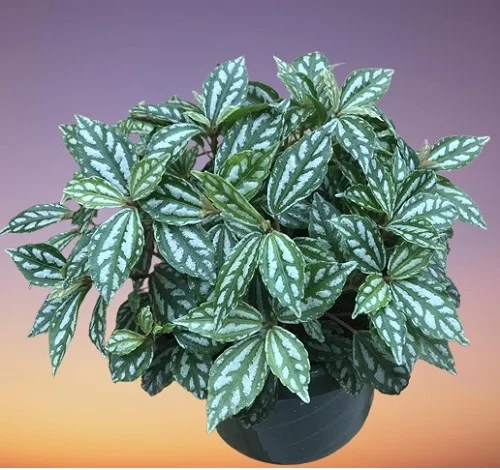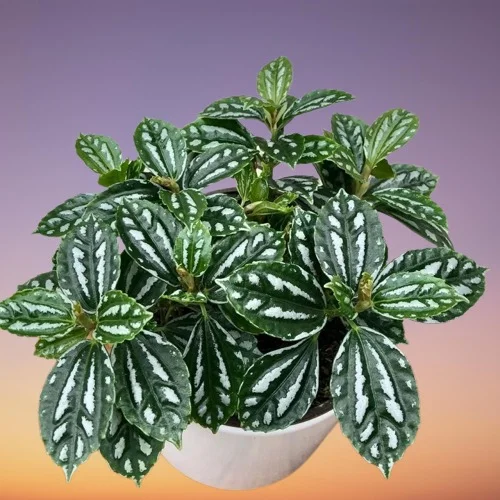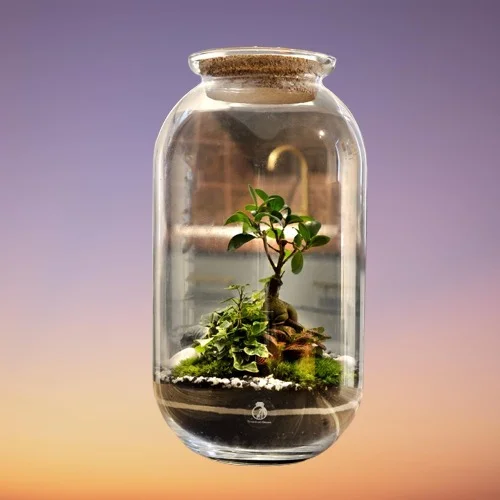Pilea cadierei (Aluminium Plant) Care Indoors, Common Problems and Remedies
Some links in this post may be affiliate links
Pilea cadierei (Aluminium Plant) grows best in bright indirect light away from direct sunlight, average warmth, high humidity and moderately moist, rich, well-drained soil coupled with monthly feeding in the growing season.
Aluminium Plant is easy-care, fast-growing, and thrives indoors with the right conditions. This guide will walk you through the best care tips, propagation methods, and solutions to common problems to help your plant flourish indoors. Let's first delve into the characteristics of this plant.
Also called Watermelon Pilea, Aluminium Plant is an evergreen plant which bears dark-green oval leaves, each bearing raised silvery patches and hence the common names.
The leaves are generally opposite on the stems and they are clearly divided into petiole and leaf blade.
Its requirement for high humidity, makes Pilea cadierei one of the best plants for a closed terrarium where a constantly humid environment can be maintained.

Botanical name: Pilea cadierei
Family: Urticaceae
Common names: Aluminium Plant, Watermelon Pilea
Origin
Pilea cadierei is native to China and Vietnam. The species name "cadierei" is in honour of the 20th century botanist R.P. Cadiere.
How big does an Aluminium Plant get?
Aluminium Plant is a low growing plant which grows to a height of 1 foot only and about 18 inches wide which places it among the best low-light plants for the limited spaces.
Flower
Pilea cadierei is monoecious which means that the male and the female flowers are on seperate plants.
Is Aluminium Plant toxic to animals?
Pilea cadierei is non-toxic to humans and pets as indicated by ASPCA. These plants are safe for cats, dogs and other pets.
Where to Buy
Aluminium Plants are a great addition to any plant collection, you may acquire them online from Etsy (Link to Etsy).

How to care for Aluminium Plant indoors
Caring for Aluminium Plant involves giving it bright indirect light (filtered light), average warmth of 18-260C, high humidity of 60-70% and moderately moist, rich, well-drained soil coupled with monthly feeding during the growing season.
Pilea cadierei care requires regular pruning to keep the plant neat and to encourage a compact, bushy growth. Repotting is needed annually to provide adequate space for growth. Keep reading for more on these growing conditions and how to achieve them.
Light Requirements
Where to put an Aluminium Plant?
Pilea cadierei needs bright indirect light to maintain the leaf color. Place it infront of a large brightly-lit window. Keep it away from direct sunshine to prevent scorching of the leaves; brown leaf marks.
Too little light will lead to a thin, leggy plant. Therefore, if natural light is not adequate, you may use grow lights to supplement it.
Pro tip:
Rotate the pot regularly to ensure that the plant receives light on all sides for uniform growth and prevent unbalanced growth.Watering
How often should I water Pilea cadierei?
Do not water your Pilea cadierei on a schedule to avoid overwatering which can result in yellowing leaves or underwatering which can lead to wilting and drooping leaves.
Water your Aluminium Plant thoroughly during the growing season and allow the top 2-3 inches of soil to dry out between waterings to keep the soil moderately moist.
Growth is minimal during the cold season, therefore, cut down on watering to keep the soil slightly moist but do not allow the soil to dry out completely.
Pilea cadierei cannot tolerate soggy soil. Therefore, ensure that the pot has a drainage hole to avoid getting soggy soil which can lead to root-rot and death of the plant.
Use chlorine-free water only as the plant is sensitive to chlorine and other dissolved chemicals and can cause staining of the beautiful leaves.
Temperature and Humidity
Pilea cadierei flourishes in an average warmth of 18-260C with a minimum 150C. Keep it away from drafts to avoid temperature flactuations which cause reduced growth and leaf drop.
Aluminium Plant excels in a humidity of 60-70%. Dry air can result in brown leaf tips and edges. To increase humidity, set the pot on a wet pebble tray or grow the plant in a well-lit bathroom and other moist areas in the home. You can also grow the plant in a terrarium.
Pro tip: Make sure that there is good air flow to your plant to discourage fungal diseases.
Fertilizer
What is the best fertilizer for Aluminium Plants?
Feed your Aluminium Plants with a balanced, liquid fertilizer every 4-5 weeks during the growing period for lush growth. Too much fertilizer can cause leaf burn (brown leaves) and leggy growth.
Do not feed in the cold season (fall and winter) as growth is minimal and feeding at this time may lead to fertilizer burn and death of the plant.
Potting Soil
What kind of soil for an Aluminium Plant?
The best soil for an Aluminium Plant should a well-draining, nutrient-rich soil that retains moisture without becoming soggy. A blend of 50% potting soil, 30% peat moss or coco coir and 20% perlite or sand is ideal for this plant.
Repotting
Repot the young Pilea cadierei annually at the beginning of the growing season as the extensive root system is known to break the pots if restricted.
Use a pot 1 size larger than the current one and ensure it has a drainage hole to prevent the soil from getting soggy which can result in root-rot. Take a look at these pots with drainage holes on Amazon.
Pruning & Grooming
Pruning Pilea cadierei involves:
- Regular removal of dead foliage to maintain the plant neat and also discourage pests and diseases infestations.
- Pinching off the growing tips to control the height and encourage a bushy, compact growth.
- Cutting back leggy stems to promote a more bushy growth.
Occasionally damp-wipe the leaves with a soft cloth to get rid of dust as well as minimize diseases and pests infestations.
Pilea cadierei Propagation
Pilea cadierei (Aluminium Plant) propagation can be done during the growing period (spring and summer) from stem cuttings and by plant division.
Learn more on how to propagate Pilea cadierei (Aluminium Plant) in 3 easy ways.

Pilea cadierei Problems & Remedies
Pilea cadierei (Aluminium Plant) problems are brown leaves, dropping leaves, plant dying, black leaves, yellow leaves, brown and shrivelled leaves, leggy growth, pests and diseases among others. Keep reading for more on these problems and how to fix them.
Brown leaves
Why are the leaves of my Aluminium Plant turning brown?
Some of the causes of brown leaves on your Aluminium Plant are soggy soil, improper watering, direct sunlight, temperature stress, and overfertilizing.
How to fix it
Soggy soil: Use a free-draining soil and a pot that has a drainage hole.
Improper watering: Water only when top 2-3 inches of soil feel dry to the touch. Never let the soil dry out completely.
Direct sunlight: Situate the plant in a shaded place away from direct sunlight or use a sheer curtain to filter the light.
Temperature stress: Keep the plant away from drafts emanating from AC units, windy doors, stoves and others.
Overfertilizing: Feed every 4-5 weeks in the spring and summer with a balanced fertilizer, do not feed in the fall and in winter.
Dropping leaves
Why is my Aluminium Plant dropping leaves?
Leaf fall in your Aluminium Plant is caused by too little light, inconsistent watering, and temperature flactuations.
How to fix it
Too little light: Position the plant in a brighter spot or use a grow light if you do not have sufficient light in your home.
Inconsistent watering: Water consistently to prevent the soil from getting soggy or too dry for a prolonged period. Use a pot with a drainage hole and soil that drains easily.
Temperature flactuations: Keep the plant away from drafts originating from windy doors and windows, AC units, stoves among others.
Plant dying
Why is my Aluminium Plant dying?
Your Aluminium Plant is dying from root-rot which is promoted by soggy soil. It is characterized by yellowing and wilting of the leaves which is rapidly followed by browning and plant collapse.
How do you revive an Aluminium Plant?
- Carefully slip the plant out of its pot and inspect the roots.
- Trim brown-black mushy roots and treat the healthy roots with a copper-based fungicide as instructed by the manufacturer.
- Disinfect the pot with the fungicidal solution or use a fresh pot to repot the plant in fresh well-draining soil.
- Do not water the plant immediately and keep it dry for some time before you resume watering.
- To prevent root-rot in the future, use a pot with a drainage hole to prevent the soil from getting soggy.
- Reduce watering in fall and winter as growth is minimal at this time; maintain the soil slightly moist.
Black leaves
Why is my Aluminium Plant turning black?
Your Aluminium Plant is turning black due to overwatering or soggy soil.
How to fix it
- Stop watering immediately.
- Remove the plant from its pot and cut away the rotten (black) parts and discard.
- Repot the plant in fresh soil. Use a well-draining soil with good aeration.
- Keep the soil dry for 5-7 days to give the plant time to recover.
- Ensure use a pot with a drainage hole to prevent the soil from getting soggy.
- Thereafter, be careful with watering; water when the top 2-3 inches of soil dry out. Do not water on a schedule.
Yellow leaves
Some of the causes of yellow leaves on Aluminium Plant are overwatering, underwatering, soggy soil, and drafts.
How to fix it
Overwatering: Do not water on a schedule. Wait until the top 2-3 inches of soil dry out before watering again.
Underwatering: Do not leave the soil dry out completely for too long. Keep it moderately moist but not soggy.
Soggy soil: Confirm that the pot has a drainage hole and the soil drains freely.
Drafts: Place the plant away from drafts to maintain a warmth of 18-260C.
Diseases
What are the diseases in Aluminium Plants?
Aluminium Plants are prone to leaf spot, root-rot, powdery mildew, and botrytis. Isolate the affected plant to prevent spread to the rest of the plant and treat it copper-based fungicidal solution. Take care to follow the manufacturer's instructions.
Pests
Common pests in Pilea cadierei are spider mites and mealybugs. Isolate the affected plant to prevent spread to other plants and treat it with neem oil or insecticidal soap. Make sure to follow the manufacturer's recommendations.
Brown, shrivelled leaf tips
Brown and shrivelled leaf tips in Pilea cadierei are caused by too dry air. Set the pot on a wet pebble tray or use a cool mist humidifier to raise humidity. You may also group the plants together to create a humid microclimate.
Leggy growth
Leggy growth in Pilea cadierei is too little light or overfertilizing. Position the plant in a brighter spot or instal a grow light if the natural lighting is not enough. Avoid too much fertilizer.
Conclusion
Pilea cadierei (Aluminium Plant), is a low-maintenance, fast-growing houseplant that thrives with proper light, watering, and occasional pruning. With regular propagation and troubleshooting, you can keep your plant healthy and vibrant for years.
Frequently Asked Questions
1. Is Pilea cadierei toxic to pets?
No, Pilea cadierei is non-toxic to cats and dogs, making it a pet-friendly houseplant.
2. How to make an Aluminium Plant bushy?
To make an Aluminium Plant bushy, pinch off the growing tips and cutback leggy stems.
3. How often should i water Aluminium Plant?
Water Aluminium Plant when the top 2-3 inches dry. Do not water on a schedule.
4. What is the lifespan of an Aluminium Plant?
The lifespan of an Aluminium Plant is 3-5 years but with good care it can live longer.
5. How much sun does an Aluminium Plant need?
Aluminium Plant grows in bright indirect light. It cannot tolerate direct sunlight.
You liked it? Share on social media.
Related Content
Amazon Associates Disclosure
Homeplantsguide.com is a participant in the Amazon Services LLC Associates Program, an affiliate advertising program designed to provide a means for sites to earn advertising fees by advertising and linking to amazon.com.





